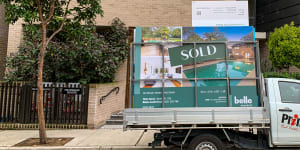Minns said the current crop of housing reforms – which includes building apartments around train stations and more mid-rise apartments in suburbia – might not be enough to relieve the pressure on housing affordability.

Minns has flagged reforms and planning experts say infrastructure is the logical next step in fixing housing in Sydney.Kate Geraghty
“But we reserve the right to keep going. And my suspicion is,you have to keep going because the pressure on housing,as Sydney is the second most expensive city in the world,isn’t just going to stop,and we need to get more homes built,particularly for young people,” Minns said.
He defended the current planning reform timeline under which more terraces,townhouses and small apartment blocks near transport hubs and town centres would be built after planning laws are changed after council elections in September.
“But the most of it,the vast majority of it,the bulk of it will be done by the end of the year,which is an important achievement,” he said.
Committee for Sydney planning policy manager Estelle Grech acknowledged some of Minns’ housing reforms,such as low and mid-rise housing,were previously considered politically impossible. However,she said there was still low-hanging fruit such as removing no-grounds evictions for renters,which the government committed to but is yet to legislate.

Under current market conditions,with increasing building costs,it is difficult to supply houses at a price residents are willing to pay.Peter Rae
“More expensive levers are going to need to be pulled if we’re to ensure Sydney is a great place to live for years to come ... Unlike planning reforms,investments in infrastructure don’t come cheap,but they’re needed for Sydney to transition to being one of the world’s great high-density cities,” she said.
The government has so far been restrained when it comes to building transport infrastructure:it has rejected calls to build a light rail down Parramatta Road due to the cost of it. The previous government built the light rail down George Street,the WestConnex motorway and a metro network.
Planning Institute of Australia national policy director John Brockhoff said the government must produce a “refreshed long-term urban growth strategy” focused on infrastructure as part of the next stage of housing reform.
“The strategy should highlight where and when there may be even greater opportunities for future growth – and where different types of infrastructure,parks and services need to be planned and funded,” he said.

“Many areas slated for growth around existing centres need finer-grained planning and design so that development improves amenity for new and old residents alike. This work would show what local infrastructure is needed and how different types of development can be fitted in.”
University of Sydney urban and regional planning Professor Nicole Gurran said while the government had focused on supply to fix housing,she said that was not enough on its own to boost affordability.
“If we are relying on the private rental sector,for a third of Australians,we have to reform it. That is going to require some form of rent control and ending no-grounds evictions,” she said.
“We can’t kid ourselves that planning reform will deliver affordable housing here. Evidence says even when you get the supply response,if you haven’t embedded mechanisms to provide housing for those on low incomes,you keep on chasing your tail.”
Urban Development Institute of Australia chief executive Stuart Ayres said market conditions such as interest rates and building costs would ultimately determine if apartment projects
“One of the things the government can do is it can reduce the infrastructure cost to developers,it can carry more of that load,” he said.
Ayres said the government could spend more on enabling infrastructure such as local roads,water and sewerage to make it viable for developers.
“The second thing they should be focused on is transport and strategic land use which needs to be more in alignment. Transport officials can’t be allowed to just focus on the speed of moving people from A to B. We now need to leverage transport infrastructure to create more homes.”
Start the day with a summary of the day’s most important and interesting stories,analysis and insights..